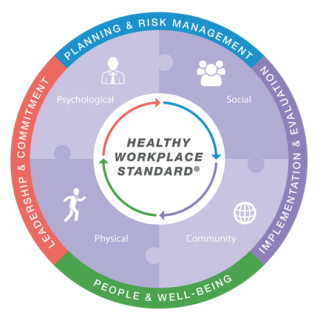Excellence Canada's Healthy Workplace standard is based on four major drivers with 19 success factors. These drivers bear significant resemblance with opportunities for improvement raised by McGill employees in recent Learning Organization and Employee Engagement Surveys.
Leadership & Commitment
1.1 Visionary leaders are committed to employee health, safety, and well-being
1.2 There is clear oversight in place to ensure an effective Healthy Workplace management system
1.3 Leaders at all levels are accountable for organizational culture
1.4 Policies are in place to support all aspects of a healthy workplace
1.5 Leaders consider the wide-spread impact of decisions on employee health, safety, and well-being
Planning & Risk Management
2.1 There is a well-communicated People plan/strategy that links directly to the overall strategic plan
2.2 A Healthy Workplace Plan (a component of the People plan/strategy) is developed with stakeholder input, and is successfully implemented
2.3 Assessments on employees’ health, safety, and well-being inform the planning and improvement process
2.4 Barriers related to employees’ health, safety, and well-being are being identified and eliminated
2.5 The organization has an effective health and safety risk management system
Implementation & Evaluation
3.1 Programs and processes for a healthy workplace are designed based on needs, preferences, and risks
3.2 Healthy Workplace programs and processes are implemented effectively
3.3 Change management is embedded in all aspects of implementation
3.4 The Healthy Workplace strategy is monitored, reviewed, evaluated and results are communicated
3.5 Employees are well-informed about the healthy workplace plan, programs, and the various resources available
People & Well-Being
4.1 The organization enables the health, safety, and well-being of employees. Physical, psychological, social, and community elements are addressed in the Healthy Workplace Management System
4.2 Equity, Diversity, and Inclusion (EDI) are embedded and reflected in daily practice
4.3 Employees participate in a robust performance management and development system
4.4 The organization has established a learning culture
